Blues Reviews
Feb/March 2018
Past
Issues Blues CD Reviews
 Backtrack
Blues Band
Backtrack
Blues Band
Make My Home in Florida
Harpo Records backtrackbluesband.com
Backtrack Blues Band do, as the title of their newest CD proclaims, “Make
My Home In Florida” and for a band that’s been on the scene
for almost thirty years they reveal a real rejuvenation. When a group
of seasoned bluesmen - Sonny Charles, harmonica and vocals, Little Johnny
Walter, rhythm guitar, Joe Bencomo, drums and Stick Davis, bass recruited
a hot young guitarist, Kid Royal, to play a mix of originals and classics
it was a partnership made in paradise. With the success of last year’s
“Way Back Home” CD they quickly enlisted a sound and video
team to record that spark before a sold out crowd at the historic Palladium
Theater in St. Pete for a deluxe CD/DVD set of tough electric blues captured
live. The DVD reveals a band that’s still on the edge, the original
players gathered together all dressed in dark suits ready for business,
the upstart Kid to the left wearing a casual newsy cap, a white shirt,
sleeves rolled up for action, primed to deliver an energetic set.
They deliver from the first notes of Sonny’s harp on Sonny Boy Williamson’s
“Checkin’ On My Baby” taking full flight as the Kid
burns on this tour de force then keeping in a blues vein Charles emulates
the Williamson harp sound while keeping the vocals all his own on Sonny
Boy’s “Your Funeral And My Trail.” From there Sonny
Charles calls for a B.B. King tribute and Kid Royal swings into “Woke
Up This Morning” supplying vocals, Charles riffs on harp as Royal
nails a tasteful solo. Sonny asks, “remember that T-Bone Walker
tune you were playing?” as the Kid takes up a “T-Bone Shuffle,”
the harp swings, the Kid sings and burns on guitar. For a final cover
the band rips into Little Walter’s “Nobody But You,”
the rhythm section is hitting hard against Sonny’s clipped vocals
while the interplay of guitar and harp is dynamic. Jacking into a heavy
groove the band kicks off their originals, chanting with every mention
of “Heavy Built Woman” as the Kid adds some sprightly guitar
and Sonny channels Ellington horns on the harp riff, then the harp crows
and cackles on “Shoot My Rooster” and Royal gives a tip of
the hat to Guitar Slim. On the title tune, “Make My Home In Florida,”
Sonny’s vocals have a lazy Southern swagger and guitar lines so
fluid they’re practically dripping and they’re well received
by the local crowd. Finishing out their originals the harp and vocals
blast out a churning delivery for “Tell Your Daddy” till Royal
reigns full swing before the harp takes back control and drives it home
for a finale.
The Backtrack Blues Band have stepped up their game on “Make My
Home in Florida” with its dual CD/DVD and as they say, cut them
while they’re hot. —Roger & Margaret White
 Kim
Wilson
Kim
Wilson
Blues and Boogie Vol. 1
Severn Records
www.severnrecords.com
Kim Wilson has been a force of nature on the blues scene since he hit
the national spotlight with the Fabulous Thunderbirds in 1979. All these
years later Wilson is still one of the busiest men in blues with his Blues
All-Stars, T-Birds and guest spots on numerous CDs. With his newest solo
shot, “Blues and Boogie Vol. 1,” he’s assembled a combination
of a dozen cool covers and four originals. With a varied cast of sidemen
including the guitars of Big Jon Atkinson, Nathan James, Billy Flynn,
Bob Welsh and Danny Michel, on bass Troy Sandow, Larry Taylor or Kandar
Roy, drums Richard Innes, Marty Dodson or Malachi Johnson with Barrelhouse
Chuck on piano and Jonny Viau adding horns. Wilson says in the liner notes
“I want to tell all of the real blues fans out there what a labor
of love this project has been. I’ve been recording many, many tracks
for a couple of years now and time has just flown by. A couple of the
greatest musicians that ever lived, Richard Innes and Barrelhouse Chuck,
have passed away during the process of making this CD. One of their dreams
was to see this stuff come out. So here it is, the first of many to come.”
So let’s jump right in and let the blues begin.
Every track has the sound of a classic Chess recording, Kim mixing and
matching players where east meets west as Billy Flynn and Barrelhouse
Chuck team up with Big Jon for a perfect rendition of Little Walter’s
“Teenage Beat” then cruise into two originals, “Learn
To Treat Me Right” and “Searching All Over” where the
guitars channel Elmore as the harp plays a Wolf-like “Dust My Broom”
chorus. Barrelhouse Chuck pounds out Big Maceo’s “Worried
Life Blues” against Kim’s soulful voice then Chuck and Flynn
hit John Lee Hooker’s “Same Old Blues” with the addition
of Jonny Viau’s sax. Kim blows an original instrumental “Edgier”
with the other California kid, Nathan James, then he bangs out a rumba
rhythm on Joe Jesea’s “No Love in My Heart.” Adding
Big Jon, Kim blows out Little Walter’s “Blue And Lonesome,”
Jimmy Reed’s “You Upset My Mind” and “You’re
The One.” Wilson knocks it out on Sonny Boy Williamson’s “Ninety-Nine”
and Willie Williamson’s “From the Bottom” with the guitars
swinging. “Bonus Boogie,” a Wilson original instrumental that
could be a Little Walter outtake, has the guitars of Big Jon and Bob Welsh
darting and flashing behind him then the same band covers Magic Sam’s
“Look Whatcha Done.”
Kim Wilson’s new collection of songs, “Blues and Boogie Vol.
1” delivers on that promise and will leave you anticipating the
next compilation he’s promised. —Roger & Margaret White
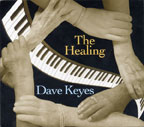 Dave
Keyes
Dave
Keyes
The Healing
Keyesland Music 2017
Keyes, with Keyes, on the keys.
Let’s forget the background biography. If you want it, just check
Guy Powell’s informative interview with Dave Keyes in the Feb/March
2016 issue of Big City Rhythm & Blues. Just accept that Keyes is a
highly valued and accomplished keyboard player, singer, and songwriter
based in New York City, with an extensive and sparkling resume. Just acknowledge
his goal, expressed in the liner notes: that the disturbing state of the
world induced him to provide an album of positive vibes. Then just sit
back and enjoy this inspired hour of gospel-tinged blues and R&B,
sprinkled with a little rock.
There is a second Keyes on this CD, by the way - David J. Keyes, no relation,
plays bass throughout the set. Handling percussion is Frank Pagano, and
guitar chores are alternated ably by Popa Chubby and Shemekia Copeland
guitarist Arthur Neilson. A few other adepts make brief appearances as
Dave Keyes works (pleasures) his way through nine original tunes and two
covers.
The set commences with “Change,” Rob Paparozzi blowing nice
harmonica over the churning rhythm section before Keyes enters with his
strong tenor voice. The powerful harmonies of backing singers The Ministers
of Sound (Alexis P. Suter, Ray Grappone, and Vicki Bell) make their first
of several appearances on the album, and Keyes delivers a nice piano solo.
It’s followed by “Dance in the Dark,” a mid-tempo shuffle
introducing horn players Tim Ouimette and Chris Eminizer into the mix.
Next, Pagano’s drums establish the Bo Diddley beat on “Not
So Nice Anymore” and Chubby belies his reputation as a warp-speed
guitarist with temperate and tasty licks…as he does again on “Ain’t
Looking for Love,” a forthright declaration to potential lovers
that sex and love are distinct. Blues singer Vaneese Thomas contributes
a great vocal, and harmonizes impeccably with Keyes.
A musical jolt ensues with the cover of the Robert Johnson classic, “Traveling
Riverside Blues”; it’s not country blues, but if the late
King of the Delta Blues could hear it, he would be startled and then probably
enthralled by Keyes’ virtuoso piano playing and impassioned vocal.
Then we reach the “hump” song of the set, the instrumental
“Boogie for Stefan,” a rollicking Keyes solo piano workout
with solid left hand and dazzling right.
“Come to Me,” a plaintive love song, is one of the highlights
of the CD, a slow tune showcasing Keyes’ and Chubby’s instrumental
skills (Keyes on organ) with horn accompaniment, and it segues into another
apex of the set, a rocking gospel cover of Sister Rosetta Tharpe’s
“Strange Things Happening.” When it’s over the urge
to dance may cease, but the church atmosphere persists with “Faith,
Grace, Love and Forgiveness,” the Ministers of Sound again singing
stirringly while Keyes and Neilson mesh scintillatingly on piano and guitar.
Neilson again excels with gorgeous restrained guitar on “Take You
Back,” a slow blues, and the set concludes with “Box of Blues,”
a tune with a big band feel that winningly brings together harmonica and
horns over another compelling Keyes vocal. It’s a fitting coda to
an uplifting album.—Steve Daniels
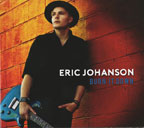 Eric
Johanson
Eric
Johanson
Burn It Down
Whiskey Bayou Records 2017
Is this yet another guitar prodigy with technical wizardry, attempting
to impress with speed and sizzle? Fortunately, no: it’s much more
than that. Johanson, a Louisiana native from a musical family, is indeed
a prodigy who was playing professionally by his mid-teens and has held
the guitar chair with the bands of Cyrille Neville and Terrance Simien.
His debut album, on the new label of Louisiana luminary Tab Benoit, reveals
that Tab has recognized a notable new talent.
Johanson is a triple threat. He takes guitar leads on all eleven tracks
of the set, sings evocatively, and wrote ten of the songs, one in tandem
with Benoit. That number, “Graveyard Queen,” is one of the
highlights; it’s a slow, spooky outing with a really nice guitar
solo and one of Johanson’s best vocals, exhibiting his command of
a wide tenor range with convincing emotional impact. Not surprisingly,
it’s enhanced by Benoit on overdubbed second guitar. The two guitars
also mesh effectively on four other numbers, including the opening title
track and, late in the set, another standout, “Oh Louisiana,”
the only cover song on the album.
Several of the songs represent an amalgam of Louisiana Cajun and Mississippi
hill country vibes; that is, they are heavy on rhythm and short on melody.
Benoit, who plays drums throughout, provides a somewhat rote hill country
groove on tracks such as “So Cold” and “Till We Bleed,”
but also some nice syncopated variety on the title tune and “Live
Oak.” The latter, an ode to New Orleans, features another of Johanson’s
stellar guitar solos. Johanson generally sticks with single note forays
on the six-string, although a series of chords introduces “4 in
the Morning,” and he can shred as well, as evinced by his Hendrix-like
treatment of “She’s in Control.”
Perhaps my favorite cut is “The Fugitive,” a tale of a miscreant
hiding from the law and repenting while enjoying protection from his paramour.
The guitar coda is worth the price of admission itself.
Corey Duplechin of Tab Benoit’s own band, on bass, is the solid
third leg of this blues rock power trio. Production values are very good,
and the album delivers the goods.— Steve Daniels
 Jeff
McCarty
Jeff
McCarty
Step Out
Whiskey Bayou Records 2017
Perhaps this regionally known and appreciated Louisiana singer will soon
be known nationally as well. Based on this album, apparently his first,
I won’t be surprised. Produced by big name bluesman Tab Benoit,
the CD contains eleven tracks, ten either written by the principal or
co-written with Benoit. Front and center are McCarty’s vocals, evincing
his capability with blues, rock, and soul, and displaying range and power.
The set commences with an optimistic anthem, “One World, One Life,
One People,” and is succeeded by “My Soul Will Never Be Free,”
which is introduced by some crunching guitar chords quickly augmented
by swirling organ. Next is “Angel Fly,” the longest track
of the set and my favorite, a beautiful dirge for a departed loved one.
McCarty’s singing is moving, as is the spare but gorgeous guitar
contribution of Josh Garrett. The ensuing title tune is a mid-tempo funky
shuffle, and the funk groove is maintained on “Live for the Music.”
“Love,” the only cover (of a Bad Company tune), is hindered
by a glacial pace and trite lyrics, but redeemed by McCarty’s vocal
and the melodious keyboard of Tillis Verdin, who switches back to organ
as the foundation for “A Thousand Miles to You,” a poignant
romantic ballad. Enough slow stuff! It’s now time to “Dance
with Me Baby,” a twelve bar enticement that’s hard to resist.
“Make Our Love Stronger” a soul ballad with a 1950s vibe,
grants McCarty the opportunity to exercise the full range of his laryngeal
skills before “Figure It Out” returns to the funk zone, and
the set ends with “Let’s Ride,” McCarty again overcoming
some clichéd lyrics with his commanding voice.
Support throughout the album is provided by Verdin on keyboards and Corey
Duplechin of Tab Benoit’s band on bass. Benoit himself mans the
drum kit, although sometimes too prominently in the mix for my tastes.
Particular kudos to Garrett, a young Louisiana guitarist with his own
band whose participation in this project is consistently excellent.—Steve
Daniels
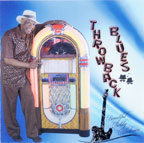 Beautiful
Bobby Blackmon
Beautiful
Bobby Blackmon
Throwback Blues
B3 Records B3Comm@aol.com
Beautiful Bobby Blackmon’s latest CD, “Throwback Blues,”
describes Bobby’s music beautifully. At 72 years old he plays the
blues he was raised on, down home Southern Soul Blues. His mother Annie
took him to blues shows in Austin, Texas, bought him his first guitar
and he would play in a band opening for big names including Lou Rawls,
Bobby “Blue” Bland, Arthur Prysock and Jerry Lee Lewis. This
disc is dedicated to the three women in his life, mother Annie Blackmon,
grandmother “Mama Sallie” and his wife Shirley Blackmon, who
he calls his inspiration. Based out of Orlando, Florida he’s a regular
at B.B. King’s with his B3 Band featuring Jimmy Seay bass, David
Bynes drums, Jack Bumgarner keyboards, Bobby Blackmon on guitar and vocals
with the occasional horn section of Doug Spoonamore sax, Derrick Harris
trombone and Chong You trumpet. All songs are written by Bobby Blackmon
in the flavor of early down home blues that he loves.
The title tune hearkens back to the days of his mom playing Junior Parker
and B.B. King as his voice and guitar recreate those warm feelings. Then
fast forward to the present, “Down In Blues Alley,” a real
place where Bobby plays, The Alley in Sanford, Florida, as the horns and
keys swing like a couple of alley cats. Slowing to a ballad Bobby pours
out his soul confessing “I Need Someone To Love Me Tonight”
then pleads “open up the door and let me in,” she says “Let
Me Think About It” but Bobby insists “Love Takes Time,”
“don’t give up on me, I’ll be your lover man wait and
see” as the guitar echoes his soulful shouts. The doctor verifies
he’s got “Love Pain” cause she cheated, leaving him
with a “Cup Of Misery” but he’ll be all right. With
a quiver in his voice and the vibrato of a B3 Bobby begs “I Wanna
Come Home” as his guitar blasts out a strong solo and the horns
blare mocking defeat as Bobby is “Gonna Put Aside My Love”
and his guitar does the crying for him. Bobby sadly looking outside himself
realizes, “The World That We Live In” ain’t the world
that I want. Bobby sings “whatcha gonna do when you can’t
find a Blues Club in your town” because “The Blues Just Left
Town” - Bobby warns “please support live music so the blues
can survive.”
“Throwback Blues” is Beautiful Bobby Blackmon’s own
blend of grit and passion. He says “the blues is at the root of
all American music, that’s why we have to keep the blues alive.”—Roger
& Margaret White
 Mick
Kolassa & Mark Telesca
Mick
Kolassa & Mark Telesca
You Can’t Do That
Swing Suit Records 2017
It’s a cliché - that means it’s true - that the basis
of almost all popular music is the blues. Rock, jazz, soul, rhythm-and-blues,
rap, hip hop, even much of country…they’re all based on our
favorite seminal American music form. We’d also probably agree that
the best, as well as most famous and most lauded rock bands ever are the
Beatles and the Rolling Stones. Not surprisingly, both bands were profoundly
influenced by the blues. Keith Richards and Mick Jagger have confirmed
that they bonded and then formed the Stones over their love of Chicago
blues, the Stones covered blues songs in their early albums, and their
2016 release “Blue & Lonesome” reaffirms the connection.
The Beatles were more influenced by 1950s and 1960s r-&-b that derived
from blues roots, and they covered many r-&-b songs in their first
outings.
Blues tribute albums to both the Stones and Beatles have seen the light
before, including 2002’s “The Blues White Album” featuring
Charlie Musselwhite, Kenny Neal, and Maria Muldaur, among others, adapting
Beatles songs. Now Mississippi-based vocalist and guitarist Kolassa has
recruited fellow vocalist and guitarist Telesca in an acoustic set reprising
eleven Beatles songs spanning the range of the Beatles recording career.
They are accompanied by album producer and skilled guitarist Jeff Jensen,
collaborator on all three of Kolassa’s previous records. James Cunningham
provides steady percussion along the way.
The duo employs several tactics to “bluesify” these tunes
so familiar to us (at least those of us of a certain age). One ploy is
to alter tempo. For example, the Beatles’s main recorded version
of “Lady Madonna” is a jaunty mid-tempo number; Kolassa and
Telesca slow it down to a dirge-like pace, and augment it with the haunting
fiddle contribution of Tommy Boroughs. Similarly, “Fixing a Hole”
is slowed, features an insistent rather than wistful vocal, and has a
virtuoso multiple guitar attack; and the title tune proceeds at a deliberate
rate, with augmentation by Eric Hughes on harmonica.
Conversely, “She Came in Through the Bathroom Window” is goosed
to an uptempo beat and a country hoedown groove. Alterations besides tempo
are also appealing. Case in point: “She’s a Woman” sports
a syncopated rhythm, added flugelhorn courtesy of Marc Franklin, and a
vocal and vibe strongly reminiscent of Dr. John and New Orleans.
“Can’t Buy Me Love,” “Why Don’t We Do It
in the Road,” “I Feel Fine” - what great songs the Beatles
gave us. Kolassa has chosen well. Imitation is indeed a form of flattery,
but this album exceeds simple imitation with innovation. Its creativity,
and its consistently fine guitar playing, deserve plaudits.—Steve
Daniels
 Ronnie
Earl
Ronnie
Earl
and the Broadcasters
The Luckiest Man
Stony Plain
Master guitarist Ronnie Earl has one of the most recognizable tones in
the musical universe. This is one of his strongest albums, which is what
is commonly stated about every album he has recorded since leaving Roomful
of Blues after his eight-year tenure (1979 until 1988). The 64 year old
has been playing guitar for better than 40 years and got his beginning
with public playing, initially jamming with Otis Rush and Big Walter Horton
in the early seventies. He played in Boston with John Nicholas and the
Rhythm Rockers and with Sugar Ray and the Blue Tones. He formed his first
version of the Broadcasters in 1988. To say he hit the ground running
is an understatement. Now, 25 albums later, his name is spoken in hushed
whispers and his name is mentioned with the greats. Otis Rush’s
and Magic Sam’s influences continues to be apparent.
“The Luckiest Man” is a well-balanced collection of stunning
instrumentals and vocal cuts with Diane Blue, and one with Sugar Ray Norcia.
The core band is Earl (guitar), Dave Limina (keys), Diane Blue (vocals),
Forrest Padgett (drums), and Paul Kochanski (bass). Guests on the set
are Nicholas Tabarias and Peter Ward on guitars, Michael ‘Mudcat’
Ward on acoustic and electric basses, Mark Earley on baritone saxophone
and Mario Perrett on tenor.
Opening with a wholly revised version of “Ain’t That Lovin’
You,” a cut made famous by Jimmy Reed and recorded by a host of
others, this is nearly unrecognizable in the more than capable hands of
Earl and Ms. Blue. Following the almost expected “Southside Stomp,”
Blue returns to deliver with Ronnie a hypnotic dirge on “Death Don’t
Have No Mercy,” the Reverend Gary Davis staple. Blue complements
“Heartbreak (It’s Killin’ Me)” a gospel-flavored
piece that shines strong on her powerful voice, and on Otis Rush’s
classic, “So Many Roads” and the closer, “You Don’t
Know What Love Is,” a song with its roots with Billy Eckstine and
by Billie Holiday. Nice version. The cut with his pal Sugar Ray (“Long
Conversation”) with Anthony Geraci, Mike Welch, Nick Gouvin and
Michael ‘Mudcat’ Ward is a major standout as well.
Guitar freaks come here for the maestro and Mr. Earl does not disappoint.
“Southside Stomp” Is a time machine on which Earl transports
the listener to the 1960s when Chicago was the center of the universe.
Earl’s lines are concise, sharp and a joy to listen to. Drums and
bass offer on time support. On “Jim’s Song,” he plays
a gorgeous extended and jazzy solo. Introspective, emotive and gentle
it evokes some shades of Wes Montgomery or Jim Hall, filtered through
the lens of a man who is certainly their peer. “Sweet Miss
Vee” is a bit more upbeat with Lamina’s organ backing. “Blues
For Magic Sam” is hard core blues with full band backing. His work
is full of spot on lines that bring the master’s influence to life.
Again, Ronnie Earl is anyone of his heroes’ equal. To call this
an amazing piece is to state the obvious. The back-in-the-mix horns are
a nice touch. Ronnie Earl is at his best and most jaw-dropping here. Whew!
This may just be the album of the year for these ears. Did I say “whew?”—Mark
E. Gallo
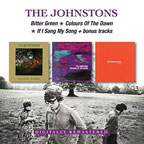 The
Johnstons
The
Johnstons
Bitter Green/ Colours Of The Dawn/ If I Sang My Song/ Bonus Tracks
BGO CD-1297
The Johnstons were an ill-fated, close-harmony folk trio (Adrienne, Lucy
and brother Michael Johnston) who were at the forefront of the Irish folk
music revival of the 1960s. They began singing in their father, Marty’s,
pub in Slane, County Meath in the early sixties, signed to Pye Records
in 1965 and had a hit right out of the box with an arresting version of
Ewan MacColl’s commentary “The Travelling People.” Their
followup single, a spirited recall of the title song for the Walt Disney
film The Alamo, quickly climbed the Irish charts and established them
as a major attraction. By 1968, after the departure of Lucy and Michael
and the addition of Paul Brady and Mick Moloney, the group signed with
London’s Transatlantic label. The three albums reissued here date
from 1969-1972 and contain a boatload of gems, including insightful covers
of titles by the likes of Pete Seeger, Leonard Cohen, more MacColl and
Gordon Lightfoot along with a slew of Brady efforts—including “Angela
Davis” and “Brightness She Came.” The 12 song bonus
section on disc two features a host of rarities including the vintage
pair mentioned above and Tom Paxton’s “Leaving London.”
Treat yourself!—Gary von Tersch
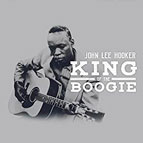 John
Lee Hooker
John
Lee Hooker
King of the Boogie
Craft
A five CD box of John Lee Hooker. King of the Boogie. King of Detroit
Blues. It’s almost overwhelming. No matter the size of your Hooker
music collection, there are going to be surprises and treats to tickle
your ears. Hooker released his first 78s in 1948, including “Boogie
Chillun” later leased to Modern Records and ultimately selling a
million copies. It is still the song most closely identified with him.
By the time he died in 2001 Hooker had amassed at least 100 albums. 100
songs are collected here. Those we know, rarities and a few never released
before, under his own name and a few others.
How does one cull a representative selection of six decades of recordings?
Carefully, delicately and lovingly. Opening with “Boogie Chillen”
(note the different spelling) by John Lee Hooker and His Guitar, it transverses
many familiar tunes: “I’m In The Mood,” “Dimples,”
“Tupelo Blues,” “My First Wife Left Me,” “Boom
Boom,” “It Serves Me Right,” “One Bourbon, One
Scotch, One Beer,” “The Motor City Is Burning,” and
“Homework” to name some of the obvious numbers. Those songs
alone are worth the price of admission. Additionally, there is s disc
full of live performances and a disc full of performances labeled as Friends;
two with Van Morrison (“Never Get Out of These Blues Alive”
and “Don’t Look Back.”). The playful duet with Bonnie
Raitt on “In The Mood” was one of the best known in his last
years. Carlos Santana shared the title tune to the great “The Healer”
album. Robert Cray shared the mic with Hooker on “Mr. Lucky”
and “You Shook Me” teamed icons Hooker and BB King. Los Lobos
(“Dimples”), Eric Clapton (“Boogie Chillen.”)
and more delights fill up the disc. Surprisingly, nothing with his friend
and producer Roy Rogers.
Concise liner notes by Jas Obrecht and Mike Kappus add to the allure of
the package. Landmarks are pointed out, such as arriving in Memphis in
1933 and then to his adopted hometown of Detroit a couple of years later,
working as a janitor at Ford, and playing house parties on the side. He
recorded under his own name, as well as such pseudo names as Texas Slim,
Delta John, Birmingham Sam, Johnny Williams, John Lee Booker, Johnny Lee,
and Sir John Lee Hooker on a variety of labels. Not all were very clever
guises, but it kept him from aligning with just one label. Package producer
Mason Williams said that the songs herein are “just a snapshot”
of Hooker’s career output. John Lee credited his style to what he
learned from his step-father, Will Moore, and to listening to 78s by Charley
Patton, Blind Lemon, Blind Blake and Leroy Carr. He is quoted as saying,
“I didn’t see these people, but I heard their music, my stepfather
had all those records.” He worked with Eddie Burns, Eddie Kirkland
and Eddie Taylor. He called T-Bone Walker a major influence. In 1959 he
embarked on a series of solo records that caught the public’s ear
as effectively as the band recordings. Following a successful trip to
Europe, he came home and finding the city’s spirit broken and far
few venues for the blues, he moved to LA shortly after the 1967 riots.
After leaving the business for nearly a decade, he made a comeback of
sorts, based in large part to a blues resurrection sparked by Stevie Ray
Vaughan. From that point forward he hit what may have been his greatest
fame. Which returns us to that first thought: A five CD box of John Lee
Hooker. King of the Boogie. King of Detroit Blues. It’s almost overwhelming.
It is the most overall enjoyable collection of masterpieces assembled
this year, or in recent memory.—Mark E. Gallo
 Heather
Newman
Heather
Newman
Burn Me Alive
Self-produced 2017
So, it must be a new trend…and a welcome one: powerhouse women vocalists
playing bass guitar in blues bands. Danielle Nicole and Lisa Mann come
to mind as such emergent figures in the last ten years; add to the list
Heather Newman, whose debut album proves that she has the goods to deliver.
Apparently a child musical prodigy, Newman in the last few years left
her roots in Omaha, Nebraska, for Kansas City. She joined guitar maven
Nick Schnebelen and his band on their 2016 release “Live at Knucklehead’s,
Vol. 1” in a fruitful collaboration. “Burn Me Alive”
showcases her talents with her own recently formed group, comprised of
young but seasoned musicians Keith Ladd on guitar, Ryan Flemmer on keyboards,
and Cole Dillingham on percussion. Oh, by the way, Newman composed all
of the dozen songs.
Holding nothing back, this quartet dives in with “Willie James,”
a chugging blues rocker buttressed by the rhythm section and by Ladd with
flashy guitar work, and immediately delivering the message that This Woman
Can Sing. As amply revealed here and throughout the almost hour-long set,
Newman has impressive range and can do smoky, sultry, and gritty equally
well. She is not always pitch-perfect, and some may find her vocals mannered,
but the passion and sincerity with which she imbues them are undeniable.
Newman is no slouch on bass, either, as evinced by the second track, “Bring
the Swing,” with its Bo Diddley rhythm, and the title tune, also
driven by her bass.
The dozen tracks furnish variety. “Howling for Love” is a
shuffle, and “Love Strong” a rocker with some nicely syncopated
drum work by Dillingham. “I Don’t Know Why,” a slow
love ballad, lets Newman exercise a full gamut of emotion. On “Share
Your Love,” Flemmer cuts loose with some evocative organ playing,
and the final track, “I’m Through with You,” is a showcase
again for Ladd. Two brief guest appearances are worthy: Schnebelen lends
his biting yet lyrical guitar prowess to “High Mountain Blues,”
and saxophonist Michael Lefever wails plaintively on “Dirty Blues.”—Steve
Daniels
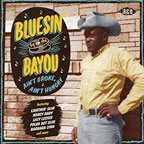 Bluesin’
By The Bayou: Ain’t Broke Ain’t Hungry
Bluesin’
By The Bayou: Ain’t Broke Ain’t Hungry
Various Artists
ACE CD 1506
This is, count ‘em, the 18th in the Ace Records series of Bayou
releases. Jam-packed at 73 minutes and 28 tracks, this well-annotated
project features previously unissued numbers and alternate takes from
the South Louisiana likes of Lazy Lester, Lightnin Slim, Clarence Garlow
and Slim Harpo plus other more obscure artists (Mercy Baby, Leroy Washington,
Jimmy Anderson and Honey Boy Allen are back porch favorites) along with
six or seven virtual unknowns including Lightnin’ Slim sound-alike
Jake Jackson and Dale and Grace sound-alike T.B. Fisher. Also represented
are a pair of artists not usually associated with this distinctively downhome
style—left-handed guitarist Barbara Lynn with her transfixing, utterly
bluesy cover of Lazy Lester’s “Sugar Coated Love” and
Cookie (of the Cupcakes) with his down ‘n’ dirty original
“In The Evening.” Also worth a mention are Big Walter Price’s
priceless admonition concerning “If Blues Was Money,” Polka
Dot Slim’s rollicking “Ain’t Broke Ain’t Hungry,”
a couple of rousers by Boozoo Chavis (especially the culinary-oriented
“Hamburgers & Popcorn” and all four sides by the immortal
Lightnin’ Slim—particularly “Little Girl Blues”
and “Hoo Doo Blues.” Can’t get enough of this music.
And there’s more to come I hear.—Gary von Tersch
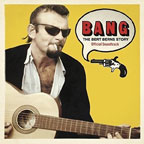 Bang:
The Bert Berns Story
Bang:
The Bert Berns Story
Various Artists
Legcy/Sony Music 2-LP
Some say that the golden era of deep soul-oriented, New York-based rhythm
and blues music died with the passing of the big-eared youthful record
executive and label owner, R&B producer and songwriter, Bert Berns,
of a heart attack in a Manhattan hotel room on New Years Eve, 1967. This
20 song collection, from the soundtrack to the recent film Bang! The Bert
Berns Story, certainly makes the case as it showcases a generous sampling
of his particular genius at paralleling gospel voices with unhurried,
climactical ballads of exceptional emotion, most of which he penned. Try
“Cry Baby” by Garnett Mimms & The Enchanters, “You
May Be Holding My Baby” by the Pussycats, Janis Joplin wailing “Piece
Of My Heart” and both “Cry To Me” and “Are You
Lonely For Me Baby” by Freddie Scott, not to mention Van Morrison’s
“Brown Eyed Girl” or The Exciters’ rousing chanter “Tell
Him” and you’ll see what I mean. This 2-LP audio counterpoint
to the film also includes the likes of Erma Franklin (with the original
version of “Piece Of My Heart”), Them (“Baby Please
Don’t Go”), Solomon Burke, The Isley Brothers (“Twist
And Shout”), the McCoys (“Hang On Sloopy”), Sam Cooke
imitator Bobby Harris and the Jarmels with their “A Little Bit Of
Soap,” Berns’ first hit from 1961. And if you want to dig
even deeper into Berns’ musical matrix check out Joel Selvin’s
recent book, Here Comes The Night: The Dark Soul of Bert Berns and the
Dirty Business of Rhythm & Blues. —Gary von Tersch
 Harrison
Kennedy
Harrison
Kennedy
Who U Tellin’?
Electro-Fi 2017
By now those familiar with Canadian blues (that is not an oxymoron) know
the name and output of Harrison Kennedy, a Hamilton, Ontario-based bluesman
with musical roots in the U.S. deep South and Detroit Motown. A high finisher
in the International Blues Challenge and a winner of multiple Canadian
blues awards, Kennedy here provides thirteen original songs buttressed
by his instrumental talent on guitar, percussion, and especially banjo
and harmonica. His voice remains his prime tool, with continued command
of the range from soul crooning to gritty rasping.
More than one other reviewer has compared Kennedy to Colorado-based Otis
Taylor, purveyor of “trance blues,” and this current release,
a follow-up to 2013’s “Soulscape” and 2015’s “This
Is from Here,” offers more evidence of similarities between Taylor
and Kennedy. Kennedy’s 2015 album presented a set of fairly traditional
twelve-bar blues, with guitar, bass, drums, and percussion supporting
his singing and harmonica displays. “Who U Tellin’?”
in contrast, harks back to the predominant vibe of “Soulscape,“
Kennedy again playing banjo and backed by adept Canadian musicians Jack
de Keyzer on guitars, Julian Fauth on piano, and Alec Fraser on bass.
Completing the ensemble is Jimmy Bowskill, who contributes mandolin and,
for the first time that I can discover on Kennedy albums, supplies fiddle.
That addition increases comparison to the stylings of Otis Taylor, whose
group prominently includes fiddler Anne Harris.
To characterize this set in a nutshell: Mississippi hill country blues
meets trance blues. The former genre, represented historically most notably
by R.L. Burnside, Junior Kimbrough, Jessie Mae Hemphill, and Fred McDowell,
sports a rhythmic groove with repetitive riffs and lyrics to create a
mesmerizing format; trance blues adds fiddle, other sundry instruments,
and an ethereal quality. Kennedy’s compositions, while similar to
Taylor’s in style, in their lyrics mine more traditional blues concerns
than the African American and Native American themes favored by Taylor.
Those who crave variety may wish for more here, since almost every song
adheres to that main groove. The good news: Kennedy and company do a consistently
excellent job of it. There are a few welcome digressions, though. “Mountain
Stomp,” for example, is a country hoedown number with Bowskill showing
fiddle skill in this tribute to “cornbread and soul food,”
and “Doctors in Hard Hats” is a more classically blues-structured
track with de Keyzer absolutely killing it with some splendid guitar soloing.
“Heavy Load” is a slow traditional blues with spare instrumentation,
de Keyzer’s acoustic guitar meshing nicely with Kennedy’s
plaintive harmonica wailing. Throughout, Kennedy’s harmonica playing,
complementing his vocalizing and sometimes dubbed over it, is pithy without
being showy.—Steve Daniels
 Marquise
Knox
Marquise
Knox
Black and Blue
Marquise Knox Entertainment 2017
Ever since his nomination in 2017 for a Blues Music Award as Best New
Artist, St. Louis-based Marquise Knox has been touted as one of the young
performers who will keep the blues alive through its predictable ups and
downs. Only sixteen when he released his first album, Knox has benefited
from mentorship from a jaw-dropping list of legends: Henry Townsend, B.B.
King, Sam Lay, Pinetop Perkins, Honeyboy Edwards, and the sensational
but under-recognized late bluesman Michael Burks. It was with Burks’
band that Knox recorded his debut album. The ensuing years have only enhanced
his reputation. His latest album is a stunner.
Knox is an undeniable crowd-pleaser and “Black and Blue,”
recorded live at the Iowa Bowlful of Blues in 2016, is proof. The nine
tunes on the set comprise a full hour-plus of terrific traditional electric
blues; each track is long, giving Knox space to stretch out and deliver
his pithy vocals and scorching guitar work. He is more than ably assisted
by Gus Thornton on bass and Michael Battle on drums, as well as Matthew
Lawder on second guitar. Seldom have I been as impressed with a rhythm
guitarist as I am by Lawder, who repeatedly lays down an impeccable and
irresistible groove as foundation for Knox’s sparkling leads. Lawder
can also bring it on lead, as he displays on the cover version of Howlin’
Wolf’s “Commit a Crime”: on that track Knox opts to
play harmonica - very well! - in front of Lawder’s Jimi Hendrix-flavored
forays.
However, it’s Knox’s guitar skill that is rightfully the focus
of the set. The man can play masterfully. The influences of some of his
famed predecessors are apparent, but Knox builds upon them rather than
simply emulating. “When My Baby Moves,” for example, is a
mid-tempo shuffle reminiscent of the blues classic “Caldonia,”
somewhat a la B.B. King. “Sweet Smell,” an r&b tune, features
scintillating interplay between Knox and Lawder’s guitars and a
lyrical solo by the former; that lyricism, characteristic of the late
Michael Burks, emerges again on “You Keep Asking Me.” Knox
can blast out rapid-fire fusillades of single notes, but more frequently
he leaves space for the solos to breathe, with potent effect.
The three longest numbers of the set are the cream of the cream. “One
More Reason (To Have the Blues),” over seven minutes long, is played
in the style of another major influence on Knox, the great St. Louis bluesman
Albert King. A standard at Knox’s live shows, “Blues Man,”
attributed to seminal bluesman Skip James, is built around the assertion
that “I’m a blues man,” and nobody could deny that after
listening to this CD. Another standard at his shows, “Can a Young
Man Play the Blues,” is an almost nine minute slow blues with licks
again evocative of Albert King. The answer to the query of its title:
a resounding YES.—Steve Daniels
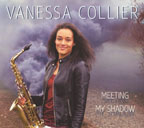 Vanessa
Collier
Vanessa
Collier
Meeting My Shadow
Ruf Records 2017
Young singer and saxophonist Vanessa Collier, based in Philadelphia, PA,
has developed a name for herself in just a few years after her graduation
from Boston’s Berklee College of Music. After a two-year stint in
the band of blues legend Joe Louis Walker and the release of her own first
album, she has garnered a current nomination for the 2018 Blues Music
Award of the Blues Foundation as Horn Player of the Year.
On her second solo release Collier is supported by an ensemble featuring
TK Jackson on percussion, Daniel McKee on bass, Charles Hodges on keyboards,
and a rotating cast of ancillary musicians who make brief appearances.
Holding down the guitar chair throughout is Laura Chavez, skilled former
lead guitarist for the late chanteuse Candye Kane.
Perhaps most surprising about “Meet My Shadow” is the subordination
of Collier’s saxophone prowess. Instead, most prominently featured
on every one of the eleven tunes is her singing, and it deserves plaudits.
Other than a rare lapse from perfect pitch, she showcases a supple, mellow
voice with nice range. It is deployed on an eclectic song list, eight
of the numbers written by Collier. The three cover tunes are well chosen.
“When Love Comes to Town,” done notably years ago by B.B.
King, receives a mid-tempo treatment enhanced by guest guitarist Josh
Roberts on slide, with Chavez also delivering some stinging riffs. “You’re
Gonna Make Me Cry” is a soul gospel track with Chavez again distinguishing
herself, Brenda Jackson sitting in on organ, and Collier and TK Jackson
providing tasty backing vocals. Late, great gospel and blueswoman Sister
Rosetta Tharpe, new inductee into the Blues Hall of Fame, was writer of
the last cover, “Up Above My Head, I Hear Music in the Air,”
and it receives a rollicking treatment here.
Overdubbing gives room for Collier to stretch, as demonstrated from the
first cut of the CD, “Poisoned the Well,” on which she eschews
the saxophone, for which she is most noted, and instead plays flute, organ,
and percussion while Chavez deploys the wah-wah pedal. After the ensuing
“Dig a Little Deeper,” one of the three infectious rockers
of the album, Collier switches to Shuitar on her original “When
It Don’t Come Easy,” Roberts again adding nice slide. (What’s
a Shuitar? Apparently it’s a guitar modified into a percussion instrument.)
The rocker “Two Parts Sugar, One Part Lime” opens with a saucy
sax introduction, and on ensuing tracks Collier shows her sax chops with
several juicy solos as well as in some intricate interplay with Marc Franklin’s
flugelhorn on the New Orleans-style “Meet Me Where I’m At.”
There’s even a “funk anthem,” “Cry Out,”
with syncopated percussion, backing vocals, and a fine sax interlude…and
the set ends with “Devil’s on the Downslide,” a slow
devotional with both Collier and Hodges playing organs.—Steve Daniels
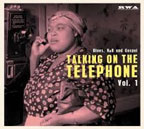
 Talkin’ On The Telephone: Vol. 1 & 2
Talkin’ On The Telephone: Vol. 1 & 2
Various Artists
Richard Weize Archives CDs 12524 & 12557 www.RWArecords.com
This pair of well-curated CDs, over the course of their 56 tracks, celebrate
two late nineteenth century inventions that revolutionized everyday life
and civilization forever—telephones and records, beginning with
early Edison cylinders. Volume One features vintage titles about the telephone
in African-American life, while Volume Two focuses on telephone-songs
from rural white American. The former begins with Johnny Otis and Marci
Lee’s jumping “Telephone Baby” and closes with Elmore
James’ frantic “I Can’t Hold Out (Talk To Me)“
with stops along the way for the likes of Lightnin’ Hopkins (“Hello
Central”), Slim Harpo, Floyd Dixon, Muddy Waters (“Long Distance
Call”), Spirit of Memphis, with their “Atomic Telephone, John
Lee Hooker, Pig Meat Markham (“Your Wires Been Tapped”), Mary
Wells and Eddie “Cleanhead” Vinson complaining about “The
People On My Party Line.” Volume Two is just as much fun with early
country hitmakers like Wanda Jackson (“Between The Window And The
Phone”), Marty Robbins, Ernest Tubb, Hank Williams, Hank Snow (“I
Just Telephone Upstairs”), The Carter Family, George Jones (“Lonely
Christmas Call”), Roy Drusky, Homer & Jethro, Bill Monroe, Lattie
Moore (“The Jukebox And The Phone”) and a round-up of lesser
lights all getting in on the action. Telephone songs go back to the dawn
of recorded sound—here’s some of the best. Gotta go—my
cellphone’s ringing!—Gary von Tersch
BOOKS
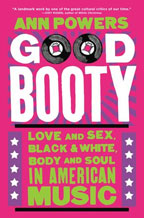 Good
Booty
Good
Booty
By Ann Powers
Dey St. Books
The front cover sub-title of this fascinating, scholarly yet easy-reading
project is, tellingly, Love And Sex, Black & White, Body And Soul
In American Music and it more than lives up to its credo as Powers comprehensively
explores how, through the ages, popular music became America’s primary
erotic art form. The title itself, of course, references Little Richard’s
crossover hit “Tutti Frutti” and Powers takes the reader from
nineteenth-century New Orleans through the dance-crazed Jazz Age to the
teen-scream years of mid-20th century rock and roll and on to the cutting-edge
adventures of today’s fervid pop stars. No holds barred. With pinpoint
precision and sly wit, Powers adroitly steers across multiple musical
genres, within and against the enveloping backdrop of the nation’s
puritanical founding, to shine a spotlight on many artists we think we
know well—from the Beatles, Jimi Hendrix and Jim Morrison to Southern
gospel, Madonna and Prince—promulgating well-thought-out insights
into our national psyche and soul along the way. The sections that deal
with Chicago, Birmingham and Memphis (circa 1929-1956), the sexual revolution
and its discontents (in New York, San Francisco, Detroit and Los Angeles,
1961-1970), the hard and soft realities of London, Los Angeles and New
York (1971-1979) as well as the up-to-date final section concerning cyberspace,
titled “Hungry Cyborgs: Britney, Beyonce, And The Virtual Frontier
(1999-2016)“ are particularly enlightening as well as entertaining.
Only bummer is the lack of a photo section—if ever a book deserved
one, it’s this one!—Gary von Tersch
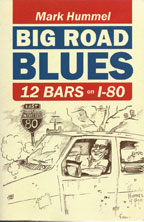 Big
Road Blues: 12 Bars on I-80
Big
Road Blues: 12 Bars on I-80
By Mark Hummel
Mountain Top Publishing LLC 2012
Tornadoes. Icy mountain roads at night at the end of a ten-hour ride to
the next gig. Blown van engines. Motels with bloody sheets, no towels,
no television or telephone, and holes in the ceiling. Promoters who don’t
promote, promoters who don’t pay. Psychotic audience members who
insist on sitting in.
It’s useful to remember that a musical career is a job for most
working musicians, and touring is stressful, to understate the case. As
top-notch contemporary blues harmonica player and singer Mark Hummel writes,
“Most folks that write about their musical history are famous -
but this is what it’s like not to be famous and [to be] without
the limos, managers, roadies, jets, beautiful models, high powered agents
and big record labels….It’s a working musician’s saga….”
In this mostly chronological litany of anecdotes, the flavor can be garnered
just from the titles of some of the chapters: “Bad Weather Blues,”
“No Lights or Heater in Colorado,” “Burning Van Fest,”
“Missing Drummer in Memphis,” “Hotel Hell Stories,”
“Frozen Canadian Goose.”
Hummel has been a touring bluesman since 1973, and he’s seen some
of thes best and definitely some of the worst aspects of gigging. Big
Road Blues presents an entertaining compendium of the assuredly many hundreds
of anecdotes that he has accrued over those four-plus decades. Although
not an autobiography, the book begins with several chapters describing
Hummel’s youth, and his irresistible attraction to blues. Like many
white blues performers of his generation, he was turned on to blues through
rock-and-roll, and curiosity about song composer names that he encountered
repeatedly. Willie Dixon? Muddy Waters? Living near the famed Ash Grove
nightclub in the Los Angeles area, he was fortunate to see many of the
seminal legends of the blues. He learned their licks from records, audaciously
asked to sit in on their shows when he felt proficient enough on harp,
and by his early twenties he was playing with them regularly and soon
formed his own band, the Blues Survivors.
One of the valuable aspects of the book is Hummel’s sketching of
many of his major influences, James Cotton, Charlie Musselwhite, and Brownie
McGhee most prominently. Encounters with other noted performers like Sonny
Rhodes, Eddie Taylor, and Lowell Fulson are alternately eye-opening or
hilarious…sometimes both. Equally interesting are vignettes of some
lesser-known figures like Sonny Lane, Johnny Waters, and Boogie Jake.
Then there are the myriad musicians that have comprised the Blues Survivors
over the years. Some remained dear friends and colleagues, some disappeared,
and some (often graciously identified only by first name) engendered intense
chagrin or animosity. It ain’t easy traveling for many weeks at
a time in a small van with anybody while suffering from sleep deprivation
and poor nutrition, but especially not with people with unpleasant habits
or contrary attitudes.
So why on earth would anyone be a touring musician, given the extreme
physical and emotional stresses? Well, Hummel answers the question in
the last chapter of Big Road Blues. “I’m a blues evangelist,
and it’s like a religion to me. Playing music on a great night is
like flying or really great sex….Even the road is like that when
you’ve been home for too long. It starts to call your name and you’ve
got to go.”
For me, this memoir has two overriding themes: Hummel’s (or any
bandleader’s) lack of control over the unavoidable vicissitudes
of life on the road, and the sheer joy of creating good music that makes
it worthwhile even so.
I have a couple of caveats about the book. Illustrations appear throughout,
courtesy of Franck Goldwasser (Paris Slim), noted guitarist and long-time
friend and some-time musical partner of Hummel. Goldwasser’s pen
and ink drawings are creative likenesses of those musicians being discussed,
but for readers who do not visually recognize the artists readily, no
identification is provided; consequently the drawings float in a frustrating
void unconnected to the text. Worse, particularly for a former English
major like me, the book is very poorly edited. There are innumerable distracting
misspellings, grammatical and punctuation errors, and word omissions and
repetitions.
Nonetheless, I thoroughly enjoyed Big Road Blues: an enlightening, amusing,
and realistic portrayal of a working musician’s life on the road.—Steve
Daniels
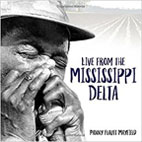 Live
From The Mississippi Delta
Live
From The Mississippi Delta
By Panny Flautt Mayfield
University Press of Mississippi
www.upress.state.ms.us
A lifelong resident of the Mississippi Delta, Mayfield is an award-winning
journalist who also has been photographing local blues and gospel musicians
at festivals, clubs, churches and juke joints for decades. Her first book
collects over two hundred black-and-white and color photos alongside detail-rich
stories and commentary and begins with a visit by archetypal rock star,
Robert Plant, to Tutwiler’s Railroad Park in 2009 where he was the
keynote speaker for a Mississippi Blues Trail marker delineating the depot
where one night in 1903 W.C. Handy heard expressive chords from a slide
guitar played with a kitchen knife. Successive chapters draw a bead on
isolating Delta landscapes (including late winter cabin scenes on Stovall’s
Plantation, where Muddy Waters grew up), homegrown icons like Early Wright,
Wade Walton, Big Jack Johnson, The Jelly Roll Kings and the North Mississippi
All Stars among others, a variety of festivals and celebrations along
with international celebrities on the order of ZZ Top, Charlie Musselwhite,
Clarence Fountain, Bobby Rush, Ike Turner and playwright Tennessee Williams.
The final three chapters deal with the Delta Blues Museum, the gospel
music scene and, my favorite—juke joints. Where we are treated to
the fast and loose insides of local fixtures like Smitty’s Red Top
Lounge (on Yazoo across the railroad tracks from the Blues Museum), the
Bobo Grocery, the Dew Drop Inn, Margaret’s Blue Diamond, the Ground
Zero Blues Club (co-owned by actor Morgan Freeman) and Red’s, to
cite a few. If you ever pondered the relevance of Mississippi to the history
of the blues, this answers the question. Robert Plant’s “mysterious
homeland” lovingly revealed.—Gary von Tersch
Home
/ Blues Blogs /
Artist Links / Blues
Links / Videos / Store
Subscribe / Advertise
/ Back Issues
/ Contact / Staff